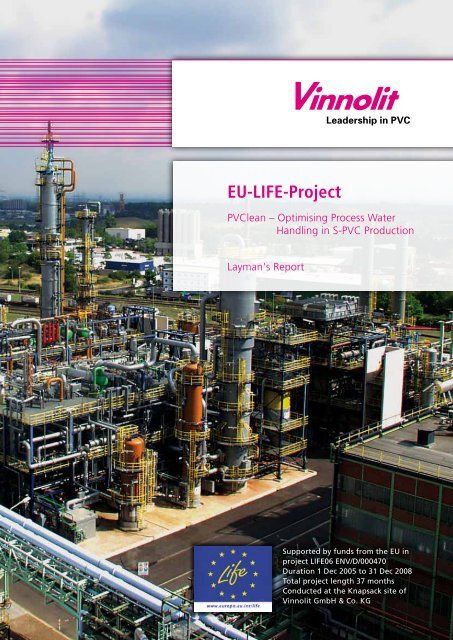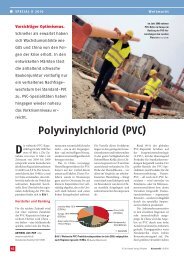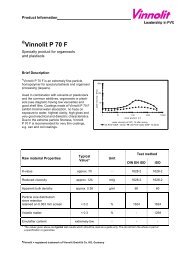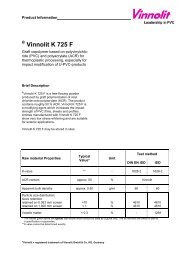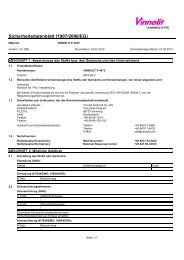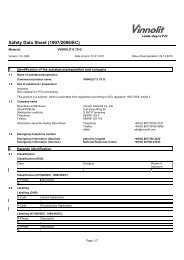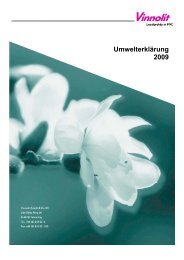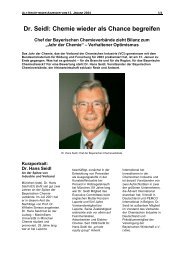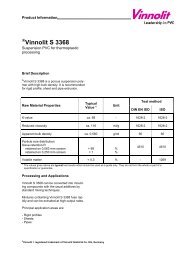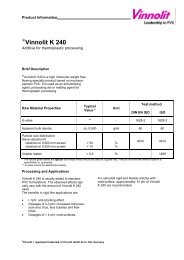Vinnolit - wise-rtd.info
Vinnolit - wise-rtd.info
Vinnolit - wise-rtd.info
You also want an ePaper? Increase the reach of your titles
YUMPU automatically turns print PDFs into web optimized ePapers that Google loves.
EU-LIFE-Project<br />
PVClean – Optimising Process Water<br />
Handling in S-PVC Production<br />
Layman's Report<br />
Supported by funds from the EU in<br />
project LIFE06 ENV/D/000470<br />
Duration 1 Dec 2005 to 31 Dec 2008<br />
Total project length 37 months<br />
Conducted at the Knapsack site of<br />
<strong>Vinnolit</strong> GmbH & Co. KG
Introduction<br />
PVC is the polymer which, in terms<br />
of quantity produced, is in third posi-<br />
tion worldwide. It is used in Europe up<br />
to 70 % for durable construction articles.<br />
Pipes are made of PVC, as are window<br />
frames, flooring and sealing sheeting.<br />
Other important applications may<br />
be found in the areas of electrics / electronics,<br />
automotive and packaging.<br />
The worldwide demand for PVC is<br />
approximately 35 m tonnes annually.<br />
In Europe, Germany is the largest PVC<br />
consumer with about 1.7 m tonnes,<br />
followed by Italy with about 900,000<br />
tonnes, as well as Great Britain and<br />
France with 600,000 tonnes annually.<br />
Globally, an average consumption<br />
growth rate of 4 to 5 % is anticipated.<br />
The largest growth rates are expected<br />
in Asia.<br />
2
Water Consumption<br />
During Production<br />
PVC is produced through polymeri-<br />
sation of vinyl chloride (VC). The pro-<br />
cess normally takes place under pres-<br />
sure in an aqueous system. The water<br />
used during the process accumulates<br />
as waste water after separation of the<br />
plastic, is cleaned in biological waste<br />
water treatment plants, and is dischar-<br />
ged into the receiving waters.<br />
The polymerisation takes place<br />
discontinuously; that is, in batches<br />
or “portions”, in a large reactor using<br />
the suspension technique (S-PVC).<br />
Vinyl chloride, fully demineralised wa-<br />
ter, and various additives are heated<br />
under pressure until the polymerisa-<br />
tion begins. After several hours, at<br />
the end of the process, about 90 %<br />
of the vinyl chloride has converted to<br />
PVC which is suspended in the form of<br />
small particles in water. In centrifuges,<br />
the water and the PVC particles can<br />
VC<br />
VC Recycling<br />
be separated from one another. This<br />
separation, however, is not 100 %<br />
effective, resulting in particular in the<br />
finest particles of PVC remaining in<br />
the water.<br />
When the waste water containing<br />
the particles is fed back into the<br />
production process, the quality of the<br />
PVC is worsened in an unacceptable<br />
manner. Thus, the water is normally<br />
discharged and fed as sewage to the<br />
waste water treatment unit of the site.<br />
Additives<br />
VC<br />
Water<br />
Polymerisation<br />
PVC<br />
Water<br />
Centrifuge<br />
Figure 1: State-of-the-art material cycle for S-PVC production<br />
Thermal<br />
Drying<br />
PVC<br />
Water<br />
PVC Solids<br />
Steam<br />
Waste Water<br />
Separation<br />
For each new production batch,<br />
new water is used. About 3 to 4 cubic<br />
metres of fresh water are needed per<br />
tonne of PVC. Because the water is<br />
not consumed during polymerisation,<br />
however, it could be led back into the<br />
production process if it were appropriately<br />
purified.<br />
PVC / Water<br />
Water<br />
Recycling<br />
Receiving Waters<br />
3
The Idea<br />
The idea at <strong>Vinnolit</strong> was, through<br />
separating even the finest particles of<br />
PVC, to be able to recover the water<br />
used purely as a carrier medium and<br />
reuse it as process water.<br />
The aim of the project “PVClean”<br />
was to develop a suitable process to<br />
enable the reuse of this process water<br />
through modification of the production<br />
process (Fig. 2). In doing so, the<br />
quantity of both employed fresh water<br />
and waste water for polymerisation<br />
was successfully strongly reduced and<br />
the environmental performance of the<br />
entire process markedly improved.<br />
Figure 2: “PVClean” process<br />
4<br />
VC<br />
VC Recycling<br />
Thermal<br />
Drying<br />
Additives<br />
VC<br />
Water<br />
Polymerisation<br />
PVC<br />
Water<br />
Centrifuge<br />
PVC<br />
H O 2<br />
Refeeding of Water<br />
PVC<br />
Water<br />
PVC Solids<br />
Steam<br />
PVC Separation<br />
PVC / Water<br />
Waste Water Treatment<br />
4 4<br />
3
The Realisation<br />
After complex pilot tests, in the<br />
context of the project, an ultrafiltration<br />
method was developed with which the<br />
PVC particles of only a few micrometres<br />
in size could be filtered from the process<br />
water. This filtration unit was subsequently<br />
planned, built, and put into<br />
operation for large-scale application in<br />
the suspension PVC facility in Knapsack<br />
(Figures 3 and 4).<br />
With ultrafiltration, the process water<br />
is fed through filter elements (Fig. 5)<br />
whose pores are large enough that<br />
the water can flow through well, but<br />
small enough that the PVC particles<br />
are retained.<br />
5<br />
The Result<br />
<strong>Vinnolit</strong> has succeeded in integrating<br />
the ultrafiltration unit into the normal<br />
operations of the production facilities.<br />
With this technology, the water<br />
originating from S-PVC production is<br />
processed and largely freed of the PVC<br />
particles (Fig. 6). The processed water<br />
can then be fed back into the production<br />
stream. Owing to this, only about<br />
1.4 to 1.5 cubic metres of fresh water<br />
per tonne of S-PVC are needed—about<br />
50 % less than before.<br />
The filter performance remains constant<br />
in the long term, so that the technique<br />
to recycle process water is also<br />
economically worthwhile.<br />
5<br />
Figure 6: Efficiency of the process<br />
(left, water directly from S-PVC<br />
production; centre, rententate<br />
[concentrated]; right, filtered water)<br />
6<br />
With an uninterrupted cycle feed,<br />
the initial goal of a 50 % savings of water<br />
was reached. Through the further<br />
development of the process, the potential<br />
for additional savings is expected to<br />
be increased.<br />
In the first six months of integration<br />
into standard operations, the ultrafiltration<br />
unit achieved an operating time<br />
percentage of over 99 %. The process<br />
and the unit have proven to be very<br />
robust. With the achieved filter performance,<br />
the project aim of saving fresh<br />
water during S-PVC production, and<br />
correspondingly reducing the waste<br />
water amount through processing and<br />
feeding back the process water, was<br />
fully reached.<br />
Figure 3: Constructing the<br />
hall and the infrastructure<br />
Figure 4: This hall contains<br />
the actual ultrafiltration unit.<br />
Figure 5: Installed ceramic filters<br />
5
The Future<br />
The process may not only be used<br />
in new facilities, but also—as proven<br />
by the project—be integrated into exi-<br />
sting production environments. In par-<br />
ticular for PVC manufacturers in arid<br />
nations in Europe (Spain, Portugal),<br />
Asia (China, India) and the Middle East<br />
(Arabic countries), the process offers<br />
an opportunity to use the scarce re-<br />
source of fresh water sparingly.<br />
The market launch of the techno-<br />
logy is to occur in the following steps,<br />
whereby the transferability of the pro-<br />
cess must always first be tested at the<br />
respective production facility:<br />
1. Introduction at <strong>Vinnolit</strong> production sites<br />
2. Presentation to the existing licensees of <strong>Vinnolit</strong> GmbH & Co. KG<br />
3. Long-term distribution through acquisition of new licensees<br />
Through this action, not only a clear<br />
reduction of the waste water discharge<br />
should be achieved locally, but also,<br />
through the use of the technology,<br />
around the globe and in the long term,<br />
fresh water consumption in the area of<br />
PVC manufacture—estimated at this<br />
time at 90 to 120 m cubic metres an-<br />
nually—should be sunken by about 25<br />
to 40 %.<br />
6
<strong>Vinnolit</strong> Group<br />
<strong>Vinnolit</strong> is—with a capacity of<br />
780,000 annual tonnes—one of the<br />
leading PVC manufacturers in Europe<br />
and worldwide under the top ten of<br />
PVC manufacturers. The national and<br />
international activities of the company<br />
are managed from Ismaning (Munich).<br />
Production sites are in Burghausen,<br />
Gendorf, Knapsack, Cologne, Schkopau<br />
and Hillhouse (UK). In fiscal year 2008,<br />
<strong>Vinnolit</strong> achieved a turnover of € 846<br />
m and employed approximately 1,500.<br />
<strong>Vinnolit</strong> produces and markets a<br />
wide range of PVC products suitable<br />
for all common PVC applications, which<br />
are used daily in, for example, the<br />
construction industry, automotive in-<br />
dustry, and medical sector. Whether<br />
PVC for window profiles, pipes and<br />
fittings, rigid film, flooring, wall cover-<br />
ing, technical coatings, automotive<br />
underbody sealant or medical applica-<br />
tions, <strong>Vinnolit</strong> is able to offer a suitable<br />
product process for every product re-<br />
quirement. In the area of PVC products<br />
for special applications, <strong>Vinnolit</strong> is the<br />
worldwide market and technical leader.<br />
Additionally, <strong>Vinnolit</strong> is a leading<br />
manufacturer and supplier of inter-<br />
mediates such as caustic soda, vinyl<br />
chloride and tin tetrachloride, which<br />
are required in the chemical industry<br />
as well as in other sectors.<br />
In conjunction with plant constructor<br />
Uhde, <strong>Vinnolit</strong> licenses the complete<br />
process chain from 1,2-dichloroethane,<br />
vinyl chloride and PVC to individual<br />
plant components and products such<br />
as, for example, catalysts for direct<br />
chlorination and cyclone dryers for PVC<br />
drying. In addition, the company possesses<br />
considerable experience in planning,<br />
constructing and modernising<br />
existing production facilities.<br />
<strong>Vinnolit</strong> is a member of the PVC<br />
and Environment Consortium (Arbeitsgemeinschaft<br />
PVC und Umwelt e. V.)<br />
and PlasticsEurope Germany, the asso-<br />
ciation of German plastics producers.<br />
For coordination and processing of environmentally<br />
relevant issues at a Euro-<br />
pean level, the company is a member<br />
of PlasticsEurope, the association of<br />
European plastics manufacturers, and<br />
the European Council of Vinyl Manufacturers<br />
(ECVM).<br />
<strong>Vinnolit</strong> supports Vinyl 2010—the<br />
voluntary commitment of European<br />
PVC manufacturers to sustainable development.<br />
The project “PVClean” was developed<br />
and implemented at the <strong>Vinnolit</strong><br />
site in the Knapsack Chemical Park,<br />
southwest of Cologne.<br />
7
For more <strong>info</strong>rmation about this project, please contact:<br />
Dipl.-Ing. Heribert Schmitz or Dipl.-Ing. Jörg Heßberg<br />
<strong>Vinnolit</strong> GmbH & Co. KG<br />
Werk Knapsack<br />
Industriestraße 149<br />
50354 Hürth<br />
Germany<br />
Tel.: 02233-48-0 (switchboard)<br />
E-Mail: heribert.schmitz@vinnolit.com, joerg.hessberg@vinnolit.com<br />
INCREON


